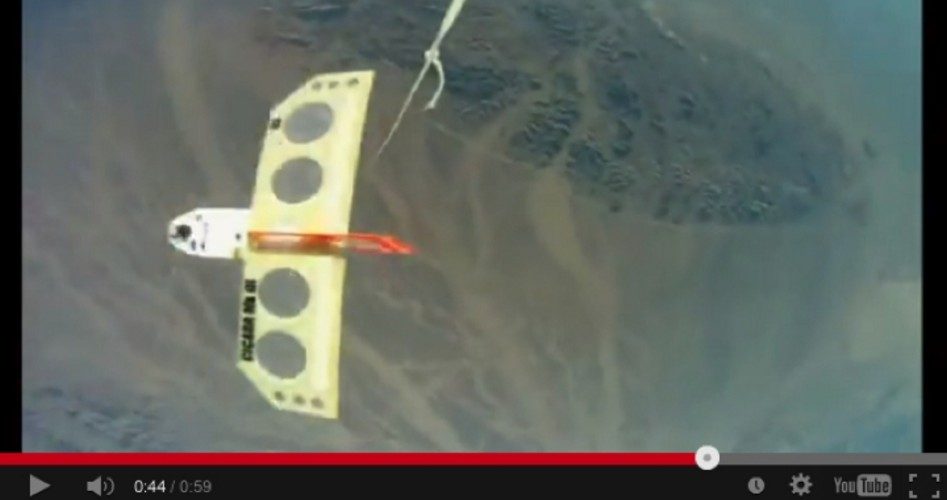
The Department of Defense is well on its way to developing various iterations of tiny drones that will give the federal government “squad level intel” on every man, woman, and child in the United States, even inside their homes.
The latest addition to the miniature monitors is the U.S. Navy’s Cicada drones. Business Insider published an AFP story describing the tiny vehicles:
US military scientists have invented a miniature drone that fits in the palm of a hand, ready to be dropped from the sky like a mobile phone with wings.
The “micro air vehicle” is named after the insect that inspired its invention, the Cicada, which spends years underground before appearing in great swarms, reproducing and then dropping to the ground dead.
“The idea was why can’t we make UAVs (unmanned aerial vehicles) that have the same sort of profile,” Aaron Kahn of the Naval Research Laboratory told AFP.
“We will put so many out there, it will be impossible for the enemy to pick them all up.”
That wouldn’t be such a threat to liberty were it not for the fact that since the National Defense Authorization Act of 2012, the United States has been designated a theatre in the “War on Terror” and Americans can be denied the most fundamental of their rights and indefinitely detained on the command of the president.
In other words, in order to appreciate the danger of these drones, one must understand the contemporary definition of “enemy.”
Unlike their larger, louder cousins, the Cicadas (an acronym standing for Covert Autonomous Disposable Aircraft) are quiet and nearly invisible until it’s too late. Business Insider reports the battlefield workings of the weapon:
It is designed to glide to programmed GPS coordinates after being dropped from an aircraft, a balloon or a larger drone, researchers said.
In a test about three years ago in Yuma, Arizona, Cicada drones were released from 57,600 feet (17,500 meters). The little drone flew — or fell — 11 miles, landing within 15 feet of its target.
The Cicada drone can fly at about 46 miles (74 kilometers) per hour and are virtually silent, with no engine or propulsion system.
“It looks like a bird flying down,” said Daniel Edwards, an aerospace engineer at the Naval Research Laboratory. But, he said, “it’s very difficult to see.”
In light of the revelations made a few years ago by this reporter regarding Trapwire — the software that allows the government to aggregate all surveillance and traffic camera video feeds and send them to federal agencies — the next potential use for the Cicadas is particularly worrisome to all defenders of individual liberty.
One possible scenario could be using the drones to monitor traffic on a remote road behind enemy lines.
“You equip these with a microphone or a seismic detector, drop them on that road, and it will tell you ‘I heard a truck or a car travel along that road.’ You know how fast and which direction they’re traveling,” a Navy official said, as quoted by the AFP.
It isn’t beyond the region of imagination to foresee a not-so-distant future where anyone audacious enough to challenge the hegemony of the federal government could have his every move monitored by these powerful pocket-sized eyes in the sky.
BizTekMojo.com reports, “Even intelligence agencies were interested in the Cicada program. It makes sense as they could be used to spy on enemy territory with minimal risks and costs. Instead of spy planes, the drones could be scattered … through fields without being spotted.”
The blog “In Homeland Security” in its report on the Cicadas suggests that the bad press generated by the civilian assassinations carried out by Predator drones may have prompted the move to shrink the vehicles. “This may replace the larger Predator class drones where such large kinetic strikes elicit diplomatic outrage and local backlash on the populations below. In spite of the tremendous amount of precision and the increased efforts and pressure to limit and lessen collateral damage, American forces are learning to go smaller and stealthier,” the blog reports.
It is informative that none of the stories, in particular the one from In Homeland Security, mentions that perhaps we should focus less on making it easier carry out kill missions and more on upholding the rule of law that supports life and liberty.
In fact, not only does the report not mention this aspect of the plan, but it seems to glorify the mortal might of the Cicada and similar weapons: “Next generation models of mini-drones might well take on the additional form of a swarming tornado of artificial locusts that could one day devastate and destroy the urban enemy in a matter of hours like the agrarian croplands. A micro-UAV locust model might become the next killer variant.”
As long as money can be made by the military industrial complex, it’s unlikely that peaceful, constitutional alternatives will ever be seriously considered.
Another disturbing fact about this deadly plague is that not only could the Cicadas monitor and record movements and conversations (the AFP report calls it a “phone with wings”), but when the mission is complete, the devices could be destroyed, as one of the selling points is that their price point makes them “disposable.” The Washington Post reports:
By the estimates of the U.S. Naval Research Laboratory, a single prototype for a CICADA can be produced for less than $1,000. And as more uses are found for these micro-drones, it’s easy to see the price falling further. One scenario being bandied about is using these CICADAS to monitor extreme weather situations, such as tornadoes. Within a few years, as more applications are discovered, that price might drop to as low as $250.
Two hundred and fifty dollars for that type of killing machine — who could say no?
Apparently, nobody. Silicon Republic reports on the durability and desirability of the tiny drones:
“They’ve flown through trees. They’ve hit asphalt runways. They have tumbled in gravel. They’ve had sand in them. The only thing that we found that killed them was desert shrubbery,” said Daniel Edwards, aerospace engineer at the US Navy’s research laboratory.
He went on to say that people from many fields, both military and civilian, are interested in the Cicada: “Everyone is interested. Everyone.”
It’s little wonder that a president that has assumed autocratic authority over life and death would want such an arrow in his quiver. That is a given. What is still a variable, however, is how the American people will respond to this latest threat to their civil liberties.
Of course, in the present climate of near-constant urban unrest, it isn’t a stretch to see the deployment of these drones justified by the urgent need to restore peace and order.
Thanks to the legal plunder perpetrated by the federal government and the billions of dollars it puts at the disposal of the Department of Defense, the watchers will soon be able to be the proverbial fly on the wall — walls within the formerly private residences of Americans.
Day by day, the dossier of dictatorship being compiled by President Obama grows thicker and thicker. From the assumption of authority to draw “First Amendment Zones” to the supposed right to capture and indefinitely detain American citizens in violation of the Fourth and Fifth Amendments and the capacity to send swarms of nearly silent, nearly invisible miniature drones throughout urban areas, President Obama and his congressional co-conspirators are attacking the constitutional barriers protecting the people from tyrants.
But the complete shredding of the U.S. Constitution protecting us from tyranny is not inevitable, and the damage already inflicted on history’s greatest experiment in human liberty can be reversed over time — if enough citizens become informed and then work with others to put the federal government back into its constitutional restraints.
Video of prototype of cicada drone: U.S. Naval Research Laboratory



